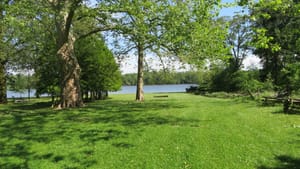Stay in the Loop
BSR publishes on a weekly schedule, with an email newsletter every Wednesday and Thursday morning. There’s no paywall, and subscribing is always free.
Sounds of the Delaware
Pennsbury Manor presents Nathan Young’s nkwiluntàmën

Plunder isn’t always glamorous. Wealth can look mundane: glass, logs, cement, peace, greenery—like the 43-acre Pennsbury Manor, a recreation of the home of William Penn. Today, this Bucks County site on the Delaware River boasts farm animals, lawns, coastal birds, and incredibly plain architecture. Once, it was clear-cut into a landscape dominated by wetlands and forests; now, it’s surrounded by trash pyramids and trailer parks. This is where Nathan Young placed his new sound installation, nkwiluntàmën: I long for it; I am lonesome for (such as the sound of a drum), running for a year at the site.
Young, an Oklahoma-born member of the Delaware Tribe of Indians (a Lenape tribe), aims to recenter the Indigenous relationship to this claimed and developed land. William Penn purchased the region’s land from the Lenape people, whom his descendants later betrayed through the infamous “walking purchase.” This manor is the historic retreat of thieving colonists, a landscape of a reconstructed past stubbornly catering to the present.
The obvious tension between these worlds should make for compelling art. Copious marketing literature for nkwiluntàmën (phonetically, “kwee-lu-nom-in”) promises a “site-specific” immersive sound installation that will reach the Lenape diaspora and enrich our understanding of the land and Indigenous people. But what we get, with curators Ryan Strand Greenberg and Theo Loftis, is a fundamentally incomplete project that barely works.
A benched installation
The installation consists of four uncomfortable benches with speakers built into them, playing an hour-long set list. There are four large signs with poetry in English on one side and typescript I couldn’t decipher on the other (described in a WHYY story as “abstract visualizations created by using the sounds of Lenape language to inform an image-generating computer code”). There is a nine-minute audio clip that bills itself as a “walking guide” but really is more of an introduction to the project and its associated history, narrated with robotic text-to-speech.
The installation’s monochrome benches (one red, one white, one black, and one yellow) are big enough to accommodate three people. From what I could observe, each bench cycles through the same series of music, but at different times or in different orders. The yellow and black benches directly face buildings, so that half or more of the view for the sitter is brick or painted walls. The red and white benches face each other at about 20 yards’ distance, and each offers its own view of the canopy, parts of the Delaware River, and the estate. I found all of the benches uncomfortable to sit on for more than five minutes.
Unobtrusive, or inaudible?
Each bench plays its sound via embedded speakers or transducers, but the music itself is hard to comment on, because this method of playback was fairly quiet and tinny, with poor fidelity. Sections with more bass did give a fun massage-chair experience, vibrating my glutes heartily.
I understand that the musical playback is supposed to color the natural sounds of the estate, but site workers were maintaining the lawn on the April Saturday when I visited, so the installation was often competing with mowers. One could interpret this as modernity drowning out Indigenous voices, but I just think it's an annoying barrier to experiencing the art.
When the lawn-mowers quieted down, I could get hints of the magic promised. Drone-y, barely there music layers itself fantastically with seagulls, geese, the sounds of the river, and the rustling of the trees. When paired with the stunning vistas that the red and white benches provided, there are moments of greatness. But on the black and yellow seats, I was bored and wished I could hear the music without being glued to the bench.

The music itself sounds like nondescript and muted versions of the artists commissioned, but with a greater emphasis on drones. I heard nothing that seemed particularly specific to the estate, Lenape heritage, Philadelphia, land-human relationships, or … well, anything thematic.
The composers for this work represent the best and brightest of contemporary classical, noise, and creative music. But the benches are a glorified mixtape. Poor playback could be hiding key elements of the work—I would like to hear these pieces again while looking into nature, with proper amplification. Nkwiluntàmën has the bones of a good project that failed in execution.
Missing in a(pp)ction
Project materials promise an accompanying app to help us “interact” with the sounds and the landscape and, on arrival, staffers advised me that the app was an important part of the experience. However, despite scouring the app store, the project’s website and Instagram page, and the physical guide, I could not find said app. The WHYY story says it’s available through a QR code, but the QR code in the provided pamphlet simply goes to the audio “walking guide,” which directs you to “use the app on your phone like a compass, and follow the compass.”
Ten days after the installation opening on Saturday, April 15, a representative for the project told BSR that an app is “coming soon,” and that it will be for offsite users, but as of publication time, they didn’t say when the app will be available. Two local media outlets parrot the press release: “Those who cannot visit in-person can experience it through the project’s accompanying phone application.”
But how can this project reach a far-flung diaspora when it cannot even reach someone who is directly at the site? (“Coming soon” is also what the project website says about details on a promised slate of associated regional public events.)
For a well-funded project (with support from Pennsbury Manor and the Pew Center for Arts & Heritage), this is a failure. Shoddy, underdeveloped parts don’t cohere into a redeemable whole. I don’t know anything that I didn’t know before, but at the very least, I got out of the city. I saw sheep and gazed on a quiet stretch of the Delaware. The wind made the river loudly break on the rocks as the sun dazzled on the water.
The installation is activated Wednesday through Sunday, from 1pm to 4pm.
What, When, Where
nkwiluntàmën: I long for it; I am lonesome for (such as the sound of a drum). By Nathan Young and other sound and music artists; curated by Ryan Strand Greenberg and Theo Loftis. $3. Through April 2024 at Pennsbury Manor, 400 Pennsbury Memorial Road, Morrisville. pennsburymanor.org or nkwiluntamen.com.
Accessibility
This outdoor area is accessible to wheelchair users, but they may be unable to experience the sound without sitting on the bench.
Sign up for our newsletter
All of the week's new articles, all in one place. Sign up for the free weekly BSR newsletters, and don't miss a conversation.

 Aaron Pond
Aaron Pond